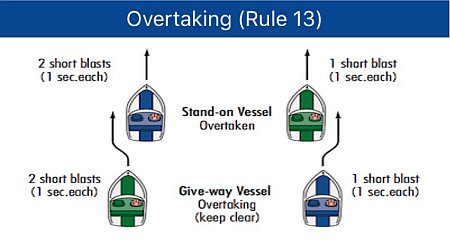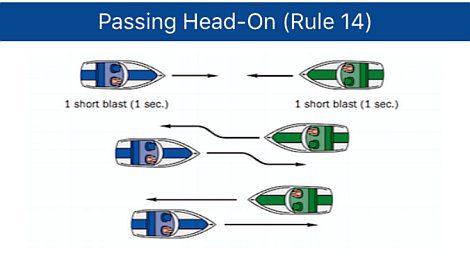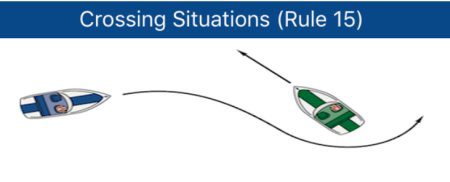 By Bob Currie, Recreational Boating Safety Specialist
By Bob Currie, Recreational Boating Safety Specialist
U. S. Coast Guard Auxiliary Station Galveston Flotilla
One of the cutter captains I have worked with has had to do twice what most captains never have to do once in their Coast Guard careers: he had to hit the Collision Alarm and announce over the speaker system to the crew to “Brace for Collision.” His cutter was rammed by an oil rig service boat twice within a few minutes. The first collision was into his transom, which caused severe damage above the water line. The second collision came when the service boat, which had gone out of control into the bank, hit full reverse and rammed the cutter a second time. Although the damage done to the cutter was over a million dollars, there were only minor injuries. That is because the crew practices collision drills frequently and they went about their business knowing that they could be involved in a collision at any time. Coast Guard sailors aren’t the only ones who need to be prepared for a collision. Recreational boaters can and should practice avoidance measures and be prepared just in case a collision does occur.
The Station Galveston Flotilla of the US Coast Guard Auxiliary operates out of the USCG Station Galveston base on Galveston Island. They aid the Coast Guard by providing maritime observation patrols in Galveston Bay; by providing recreational boating vessel safety checks; and by working alongside Coast Guard members in maritime accident investigation, small boat training, providing a safety zone, Aids to Navigation verification, cooking in the galley, on the Coast Guard Drone Team and watch standing.
Types of Collisions at Sea
There are some general types of collision, each of which has its own special considerations. Understanding the different circumstances that lead to a collision can help you prepare for such an event. This preparation includes methods of collision avoidance as well as methods of mitigating damage or injury when a collision occurs. The basic types of collisions involve your boat striking a stationary object or a collision between vessels while underway. The term collision only applies to a situation in which there are two vessels and both vessels are moving, while a situation in which a vessel underway strikes a stationary object or land is call an allision. Since that term is so rarely used outside of official documents and investigations, we will go with the colloquial use of collision to apply to an allision also.
Collision avoidance is the prime reason for having the Rules of the Road, which we will now discuss. The following are excerpts from the Inland Navigation Rules and the International Regulations for Preventing Collisions at Sea (COLREGS). Inland Rules apply to vessels operating inside the Line of Demarcation, while International Rules apply outside that line. There is no general rule as to the location of the Line of Demarcation. It differs according to location. It can be as close as the beach or it could be many miles out. You should refer to a chart for your area of operation. For instance, in my area, Galveston, the Line of Demarcation is the end of the north and south jetties, or just over three miles out. The only purposes of the Line of Demarcation are to determine where Inland Rules are to be used and International Regulations are used, and where sea time occurs as far as mariners’ licensing requirements are met.
The Line of Demarcation is often confused with the U.S. Boundary Line. The U.S. Boundary Line generally follows the high tide waterline along beaches and shores, and extends across the entrances to small bays, inlets, harbors, rivers, the ends of breakwaters or jetties, etc. In most cases this means that as soon as an outbound vessel crosses seaward of the entrance, it has crossed outside the Boundary Line. In the Gulf of Mexico between the Marquesas Keys, Florida, and the Rio Grande River mouth, the Boundary Line is located 12 nautical miles offshore. Ask even the most seasoned recreational fisherman where the Line of Demarcation is for Texas and they will state with 100% assurance that it is 12 miles out. Get ready for an argument if you state otherwise. Here are some excerpts from the Rules of the Road that will help you understand what your responsibilities are as the operator of a vessel.
Responsibilities Between Vessels (Rule 18)
This rule is often called the Pecking Order. Except where Narrow Channels (Rule 9), Traffic Separation Schemes (Rule 10) and Overtaking (Rule 13) situations exist, the following applies:
(a) A power-driven vessel shall keep out of the way of:
(i) a vessel not under command (NUC);
(ii) a vessel restricted by her ability to maneuver (RAM);
(iii) a vessel engaged in fishing;
(iv) a sailing vessel.
(b) A sailing vessel underway shall keep out of the way of:
(i) a vessel not under command (NUC);
(ii) a vessel restricted in her ability to maneuver (RAM);
(iii) a vessel engaged in fishing.
(c) A vessel engaged in fishing while underway shall, as far as possible, keep out of the way of:
(i) a vessel not under command (NUC);
(ii) a vessel restricted in her ability to maneuver (RAM).
Post a Lookout (Rule 5)
This is key to avoiding a collision. Designate someone to watch for dangers that may come from any direction, including partially submerged objects or objects below the water that may be seen when water visibility is good. Here is the rule:
“Every vessel shall at all times maintain a proper look-out by sight and hearting as well as by all available means appropriate in the prevailing circumstances and conditions so as to make a full appraisal of the situation and of the risk of collision.”
Rule 6: Safe Speed
Except where speed is restricted by regulation or the waterway is marked by a “No Wake” or “Slow Speed” aid, you must judge “safe speed” for yourself. You must take into account the following:
- Visibility
- Vessel traffic
- Your boat’s ability to maneuver
- Background lighting at night
- Draft in relation to depth of water
- Weather Conditions (including wind, sea, current and proximity to hazards)
Rule 7: Risk of Collision
Rule 7 comes into play whenever another vessel is detected, whether by sight, hearing, Automatic Identification System (AIS), or radar. Below is the wording of the rule:
(a) Every vessel shall use all available means appropriate to the prevailing circumstances and conditions to determine if risk of collision exists. If there is any doubt such risk shall be deemed to exist.
(b) Proper use shall be made of radar equipment if fitted and operational, including long-range scanning to obtain early warning of risk of collision and radar plotting or equivalent systematic observation of detected objects.
(c) Assumptions shall not be made on the basis of scanty information, especially scanty radar information.
(d) In determining if risk of collision exists the following considerations shall be among those taken into account:
(i) Such risk shall be deemed to exist if the compass bearing of an approaching vessel does not appreciably change (CBDR: Constant Bearing with Decreasing Range equals risk of collision).
(ii) Such risk may sometimes exist even when an appreciable bearing change is evident, particularly when approaching a very large vessel or a tow or when approaching a vessel at close range.
As you can see from this rule, just detecting an object is not enough; you must plot an object’s course to determine if a risk of collision exists early enough to alter course if necessary to avoid a collision.
Rule 8: Actions to Avoid a Collision
Below are excerpts from the first five sections of Rule 8:
(a) Any action taken shall be positive, made in ample time and with due regard to the observance of good seamanship.
(b) Any alteration of course and/or speed to avoid collision shall be large enough to be readily apparent to another vessel observing visually or by radar; a succession of small alterations of course and/or speed should be avoided.
(c) If there is sufficient sea room, alteration of course alone may be the most effective action to avoid a close-quarters situation provided that it is made in good time, is substantial and does not result in another close-quarters situation.
(d) Action taken to avoid collision with another vessel shall be such as to result in passing at a safe distance. The effectiveness of the action shall be carefully checked until the other vessel is finally past and clear.
(e) If necessary to avoid collision or allow more time to assess the situation, a vessel shall slacken her speed or take all way off by stopping or reversing her means of propulsion.
Changes in Course or Speed
Rule 8 says that any alteration of course and/or speed to avoid collision shall be large enough to be readily apparent to another vessel observing visually or by radar, and that a succession of small alterations of course and/or speed should be avoided. You want the other operator to know your intentions. If there is sufficient sea room, alteration of course alone may be the most effective action to a close-quarters situation provided that it is made in good time, is substantial, and does not result in another close-quarters situation. The most important thing in these cases is to be aware of all vessel traffic that could potentially cause a collision with you. That is why you must have a lookout.
Overtaking (Rule 13)
There are three important considerations when overtaking. The first consideration is to understand which vessel has the right of way. It is simple. Any vessel overtaking (passing) any other vessel shall keep out of the way of the vessel being overtaken. The nautical term for the overtaking vessel is “Give-way Vessel.” The term for the vessel being overtaken is the “Stand-on Vessel.” Both terms are self-explanatory. As the give-way vessel, you must give way (take actions necessary to avoid a collision), while as the stand-on vessel it is your job to maintain a constant speed and heading; that is, you stand on a steady course. Before changing course, you should make sure you are not being passed by another vessel. Many collisions occur when what should have been the stand-on vessel in a passing situation suddenly makes a turn either to port or starboard.
The second consideration is to signal to the other vessel your intent to overtake, and for the vessel being overtaken to signal that they understand. To pass on the port (left) side of the stand-on vessel, the give-way vessel first gives two one-second blasts of the horn, and the stand-on vessel acknowledges by giving two short blasts. Passing on the port side is the normal rule when there is enough room to do so. Sometimes the give-way vessel may desire to pass on the starboard (right side). In that case, the signal is one short blast.

The third consideration is executing the pass safely. If either boat operator feels that there is a risk of collision, then the horn signal to be given is five short, quick blasts of the horn. The pass should be executed only when it is safe to do so; that is, there is room to pass and the give-way vessel’s wake will not cause damage and proximity to the stand-on vessel does not pose a risk of collision. It’s just like passing a car on a two-lane highway.
Passing Head-On (Rule 14)
Unless otherwise agreed, when two power-driven vessels are meeting on reciprocal or nearly reciprocal courses so as to involve a risk of collision, each shall alter her course to starboard so that each shall pass on the port side of the other. In other words, keep right. Yes, it is that simple, but we saw several boats zig-zag as they approached each other, neither operator seeming to know what to do. The horn signal is one short blast. If there is any doubt about what the other vessel intends to do, the rules require you to take action to avoid a collision. In addition, sound the distress signal (5 short blasts).

Crossing Situations (Rule 15)
When two power-driven vessels are crossing so as to involve a risk of collision, the vessel which has the other on her own starboard side shall keep out of the way and shall, if the circumstances of the case admit, avoid crossing ahead of the other vessel. This is just like coming up to a 4-way stop on a highway, but there are no stop signs or yield signs. You just have to remember the rule: the vessel on your right has the right-of-way (otherwise it would be the left-of-way, right?).

Bracing for a Collision
So far we have talked about how to avoid a collision. Sometimes even when all precautions are taken a collision does occur. In my friend’s situation he was anchored and his crew was in the process of bringing a large navigation buoy aboard when he determined that the service boat was about to hit his cutter. In strict terms “bracing for collision” means grabbing hold of something solid to keep from being tossed about or even overboard. But it is also a mindset that sailors are taught; that is, everything they do takes into consideration the possibility that a collision may occur. They make sure they have secure footing; they make sure passageways are clear; and they make sure equipment is either properly stowed or placed where it won’t fall and cause injury or damage. They remain aware of their surroundings, keeping in mind that if a collision does occur they will have little warning if any. They frequently have collision alarm drills.
So how does all this translate for the recreational boater? Let me answer a question with a question: Have you ever left your tackle box on the back of a seat or the rear deck because you were just moving to the next reef? Imagine what would happen if you struck a shoal and came to a sudden stop from 30 mph and that 5-pound tackle box became a missile headed for your head. If you secure your equipment and make sure your passengers are properly seated and holding on, if you see you are about to collide with something, yelling “brace for collision” will likely minimize injuries to persons aboard from flying equipment and bodies. If you really want to be thorough, instruct your passengers that if they hear you say “brace for collision” they should immediately take ahold of something solid such as a handrail or brace themselves as best they can. If they are forewarned they stand a better chance of coming out unscathed.
Reporting Collisions
Operators or owners of a vessel involved in an accident must report the accident to their state boating authority when, as a result of an occurrence that involves the vessel or its equipment if:
- A person dies,
- A person is injured and requires medical treatment beyond first aid,
- Damage to vessels and other property totals $2,000 or more or there is a complete loss of any vessel,
- A person disappears from the vessel under circumstances that indicate death or injury.
As you can see from the list, minor bumps in the docking are most likely would not meet the threshold for reporting.
Summary
If you understand that there are roads on our waterways, then you should be able to understand the Rules of the Road for those waterways. If everyone followed them, there would be far less collisions. It’s that way for our land-based roads, too. Just keep in mind that if you have a collision on a land-based road, help is just minutes away. However, if you have a collision at sea, help is at best several hours away, and only if you have the proper means for calling for help. While prevention is your best option, knowing how to prepare your boat and your passengers for collision could save someone’s life.
For more information on boating safety, please visit the Official Website of the U.S. Coast Guard’s Boating Safety Division at www.uscgboating.org. Questions about the US Coast Guard Auxiliary or our free Vessel Safety Check program may be directed to me at [email protected]. SAFE BOATING!
[Feb-1-2022]

 Posted in
Posted in 























